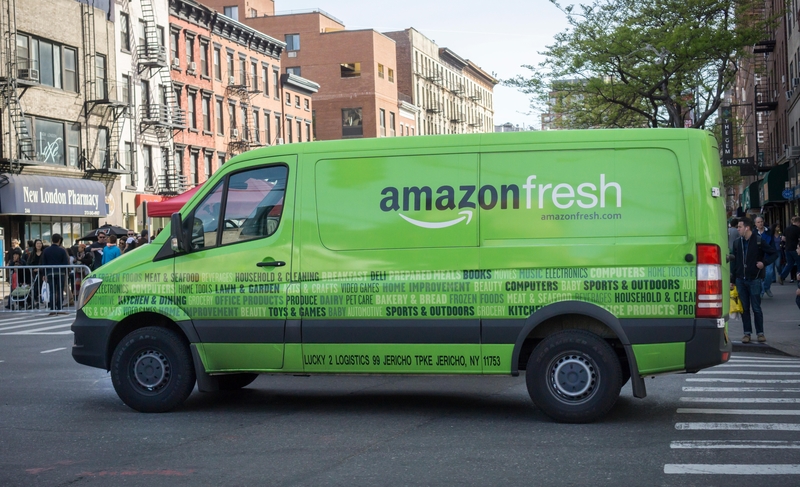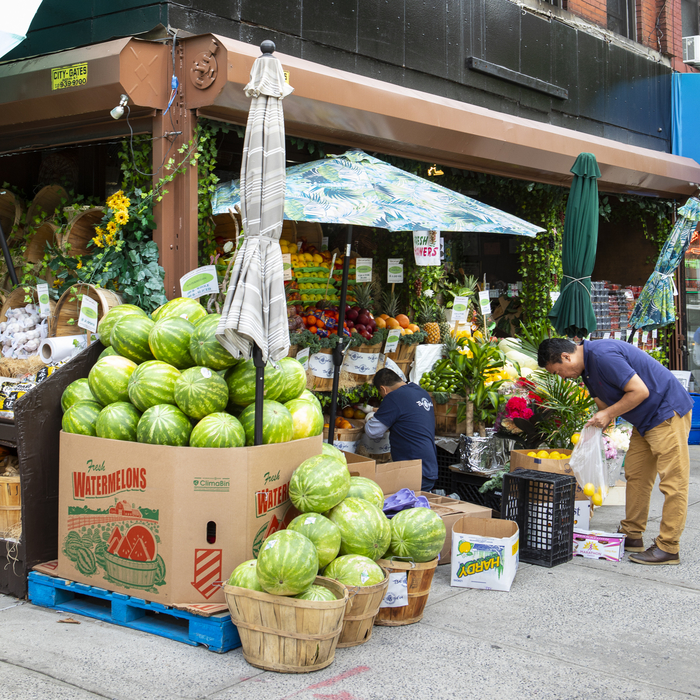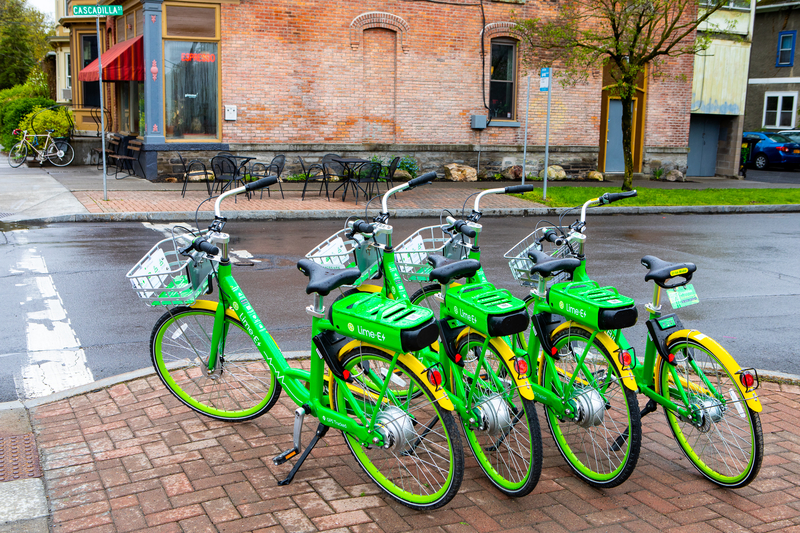A fresh approach to helping the planet: Elena Belavina takes on food waste

Elena Belavina, SHA associate professor of operations management. © Jon Reis
As a graduate student in Paris, Elena Belavina enjoyed the luxury of having a grocery store across the street from her apartment. “Every day on the way back home” from INSEAD, where she studied for her PhD, “I would just pick up whatever I wanted for dinner. So literally, my refrigerator was empty—you know, maybe a yogurt.”
That yogurt was not lonely for long after Belavina was hired as an assistant professor at the University of Chicago’s Booth School of Business. “As a junior faculty member you work a lot. The grocery store was far away, and it was such a hassle to drive there and park that I used to buy a lot of stuff and then end up throwing a lot of it away”—as so many of us do. But Belavina is no average consumer, and she saw this as an intriguing problem to look at, especially when she discovered an alternative to those after-hours provisioning runs. “AmazonFresh came about, and you could subscribe and buy a little bit at a time. I thought, ‘Hmm, that’s probably smart.’”
Belavina, who is now an associate professor at the Nolan School of Hotel Administration in the SC Johnson College of Business, is a supply-chains expert with a doctorate in operations management and bachelor’s and master’s degrees in applied mathematics and physics. Retail and supply networks interest her, as does sustainable urban living.
Her curiosity about the relative merits and minuses of stocking up somewhat randomly at a supermarket versus having small orders delivered as needed ultimately set a new direction for her prolific research program. Those initial musings formed the basis for her first study on food waste, “Online Grocery Retail: Revenue Models and Environmental Impact,” which was published in Management Science in 2017.
Belavina’s Chicago experience also inspired the study “Grocery Store Density and Food Waste,” which is due to be published this year in Manufacturing and Service Operations Management.
An environmental impact crater
How much does food waste matter? A lot more than people may think, actually. “More than a third of all food that is produced is wasted,” Belavina states in the introduction to her forthcoming article on grocery store density. “The carbon footprint of this wasted food is comparable to that of all road transport and is just behind the entire footprint of the top two emitting economies, the United States and China.”

This impact crater of a footprint represents the accumulated cost of food waste from production to decomposition. Growing alone accounts for about 80 percent of the emissions total, but discarded food also produces carbon dioxide when it is composted or, much worse, methane when it is dumped in a landfill. (Methane converts to carbon dioxide, ozone, and other gases after 10 or 20 years, but it does far more significant damage in the short term. On a per-unit basis, its 20-year global warming potential is 84 times that of carbon dioxide, according to the Environmental Protection Agency and the UN’s Intergovernmental Panel on Climate Change.)
“In developed countries,” Belavina writes, “more than two-thirds of food waste arises at the retail and consumption stages of the fresh grocery supply chain.” The habitual offenders among us who thought we were more or less doing our part for the environment may well find this news discomfiting. Feeling guilty won’t get us very far, however. “People can change their behavior for a little while, but then life sets in and they go back to their regular behavior,” Belavina noted wisely.
“What we need to do is fundamentally change the economics of shopping.”
You can have that delivered
In their study of online grocery retail, Belavina and her collaborators—Karan Girotra, a professor at Cornell Tech and the Samuel Curtis Johnson Graduate School of Management, and Ashish Kabra, a former doctoral advisee now at Maryland—compared buying perishable groceries at the supermarket to ordering them online. They further compared “per-order” online shopping, which tacks a shipping charge onto each order, to subscription-based online ordering, which instead charges a fixed annual fee.
Using Paris, old-city Beijing, Manhattan, and Los Angeles as models for their study, the authors analyzed “offline” grocery shopping and the two online scenarios to compare two bottom lines for households: the amount of food that is bought unnecessarily and then thrown away, and the total money spent on fresh groceries. Assuming same-day delivery, they demonstrate that it is better to have your groceries trucked to you, even daily, than to load up on perishables in advance of uncertain needs.

For every urban geography studied, both the environmental and the financial costs were found to be lower when customers are able to order as little as they want as often as they want. Since delivery fees can also give consumers an incentive to place larger, less frequent orders, subscription-based buying turns out, surprisingly, to be the best approach “for all plausible ranges of parameters for the cities of Paris, Beijing, and Manhattan,” three of the four cities modeled. Because driving distances are so much greater in Los Angeles, the per-order approach has the edge there.
“The carbon impact of extra food waste turns out to be much higher than that of extra driving” to deliver the groceries ordered online, the paper concludes. And the more deliveries an online supplier makes in an area, the lower the environmental cost of any one delivery becomes. The subscription model is also more profitable for both the online seller, who can charge more for the groceries, and the consumer, who ends up paying less overall for perishables.
Or stop by the corner store
Belavina’s forthcoming paper provides the first analysis of store density’s impact on food waste.
Chicago, she said, happens to be a fairly typical city in terms of grocery store density, and it serves to illustrate several of the points she makes in the article. For example, she found that having just three or four more stores in every area of 10 square kilometers would decrease food waste in Chicago by 6-to-9 percent. The environmental impact of that seemingly modest decrease “would be equivalent to converting over 20,000 cars’ engines from internal combustion to electric power,” the paper states. “This is far more impact than has been achieved by the substantial subsidies offered to buyers of electric cars.”
As in her study of online grocery buying, Belavina found that the ability to shop nearby as often as needed decreases not just food waste but also total grocery expenditures, despite the higher price of groceries at a corner store. “Decision-makers should strive for grocery density increases without hesitation,” she writes, “as these are a win-win for the environment and for consumers.”

It is true that the increased competition and consumer choice that come from having more stores in an area make it harder for grocers to predict demand week-to-week and maintain the same profit margins. The increased difficulty in judging inventory in advance increases both retailer food waste and costs, but not to levels anywhere near those seen with consumer waste. Belavina found that, in all scenarios studied and at typical urban store densities, consumer waste exceeds retail waste by a factor of 10. Increasing access to fresh groceries should decrease consumer food waste to a greater extent than it increases retailer food waste. And there is a lot of room to increase the number of neighborhood stores; not even New York City has reached optimal store density, although it comes the closest to it.
Weighing in with the food-service industry
Two months after Belavina began her first semester as an SHA faculty member in 2018, she took part in a hospitality industry roundtable discussion focused on sustainability. In that full-day session, she first saw how great the possibilities would be to do collaborative industry research at Cornell. “I brought up the fact that I’m working on food waste, and practically everyone in that room had on their agenda to do something about it,” she said. “Cornell is just absolutely amazing—especially, for me, the connections to industry that we have in the Hotel School.”
As a result of one of the contacts she made that day, Belavina is now planning a study of kitchen and post-consumer food waste in the employee dining facilities of a major hotel company. “Restaurants are the other big culprit besides households” in terms of food waste, she said. “It’s not being measured, so they don’t know exactly how much they are throwing out.”
More recently, she has also been talking with a chain of salad-focused restaurants about another kitchen food-waste study. Both will use a device developed by Winnow Solutions that measures what is thrown away.
“It’s a trash can that sits on a scale,” she said, “and with a tap of a few buttons, the restaurants can record precisely what’s being thrown away, whether it’s red onion peels or steak from a customer’s plate. That’s really a first-of-its-kind data set, because this kind of food waste is nowhere being rigorously recorded. We’ll be able to much more easily have amazing, very granular data that will allow us to help restaurants portion their plates. It’s early on, but we’re excited about this.”
Belavina was also approached recently by an international consortium of major grocery retailers, the Efficient Consumer Response Community Shrinkage and On-Shelf Availability Group and the Consumer Goods Forum. “They commissioned us to do research on how the contracts between suppliers and retailers affect the amount of food waste across the supply chain,” she said. “They’re very much at the forefront not only on reducing their own food waste but in recognizing how changing their interactions with other actors in the supply chain could have a huge impact on food waste. So industry is embracing the issue. Not only does it have environmental implications, but it’s also a huge cost to them, so if we can really address it and find ways to make it better for everyone, it will be a win-win-win.”
“And then you look at Cornell overall,” she said. “We’re already starting to talk with the Dyson folks who work on food waste with the World Bank, and hopefully we’ll start collaborations there.”
Connecting at Cornell

Belavina has also been filling the publications pipeline with research papers relating to social networks, crowdfunding platforms, and improving the design of bike-sharing networks. She made research presentations last year for the Center for Sustainable Global Enterprise in Johnson, Cornell’s Atkinson Center for a Sustainable Future, where she is a faculty fellow, and the Charles H. Dyson School of Applied Economics and Management. She has discussed her bike-share work with faculty in Cornell’s School of Operations Research and Information Engineering.
“I am connecting with so many different parts of the college and Cornell and talking with so many people,” she marveled. “The potential is enormous for me and the kinds of things that I do here. I was at Chicago for six years and I didn’t talk to anyone outside the school, not a single person. Here at Cornell, it’s just a whole different community. I love it—every day of it—here.”

1 Comment
Jon Reis
Elena,
WoW you are so connected!
Did you get a new photo for your office door from my collection?
Comments are closed.